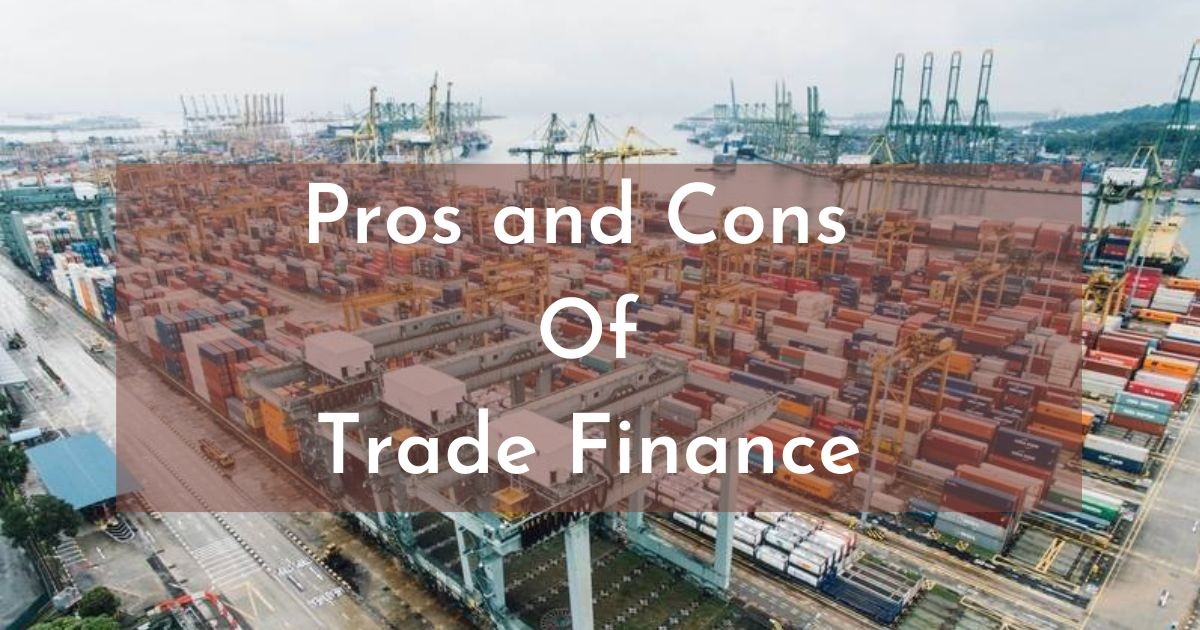Blog Detail
The Pros and Cons of Using Trade Finance to Finance Your Business

If talking about trade finance then it is a specialist financial service which offers money and help to international trade firms. It provides a variety of financing choices and technologies to support export and import transactions, assisting businesses in overcoming financial obstacles and expanding their business activities in the worldwide marketplace. While trade finance may be extremely advantageous to organizations, it is critical to recognize both the benefits and drawbacks of adopting trade finance as a funding solution.
Trade finance delivers the financial instruments and services required to support both export and import activity. It lets companies buy and sell products and services across boundaries, hence strengthening international trade partnerships. Trade finance helps economic growth and worldwide commerce through offering access to money, minimizing risks, and promoting seamless transactions.
International trading frequently necessitates considerable upfront investments as well as working capital. Import and export financing, for example, offer businesses with the capital needed to cover costs, purchase goods, and fulfill orders. The ability to have access to working finance is especially important for SMEs with inadequate funds but a desire to extend their operations abroad.
In this post, we will look at the benefits and drawbacks of using trade financing to fund your firm, with a specific emphasis on import finance.
Advantages of Using Trade Finance:
1. Working cash Access: One of the most significant benefits of trade finance is the availability of working cash. Importing goods frequently necessitates large upfront payments to vendors. Trade finance, like import financing, allows firms to fill the cash flow deficit by offering funds to pay for items prior to shipment or upon receipt. This quick access to working money enables businesses to complete orders, keep inventory, and capitalize on growth prospects.
2. Risk Mitigation: Risks associated with international trade include nonpayment by foreign purchasers, instability in politics, and currency volatility. Credit Letters and insurance for export credit, for example, serve to limit these risks. Payment guarantees are provided through letters of credit, which ensure that vendors get payment whenever the agreed-upon requirements are met. Export credit insurance shields companies from the risk of nonpayment by international buyers. Businesses are able to trust in global trade and increase their consumer base by utilizing these risk reduction strategies.
3. Better Cash Flow Management: It is crucial for the success of any firm, especially those involved in international trade. Trade finance options, like invoice financing and factorization, enable firms to transform accounts receivable into cash immediately. This increases cash flow by releasing monies from delinquent invoices. Businesses can satisfy their financial responsibilities, pay suppliers on time, and invest in growth projects by releasing working capital.
4. Improved Market Expansion: Trade financing helps businesses expand into new markets by providing them with the financial resources they need. Import finance, for example, allows companies to finance the acquisition of items from foreign suppliers. Businesses can gain access to a larger consumer base, expand their sources of income, and explore potential for expansion by entering global markets.
The Drawbacks of Utilizing Trade Finance:
1. Price: Trade financing services have related prices and fees. When compared to standard financing solutions, rates of interest, processing charges, and other expenses may be higher. The price of trade finance may differ based on factors such as the business's creditworthiness, the transaction's complexity, and the individual trade finance solution used. To assess the feasibility of trade finance as a means of funding, businesses must carefully weigh the costs and benefits.
2. Documentation and Complexity: Trade finance transactions can involve extensive documentation and requirements for compliance. Letters of credit, for example, necessitate stringent adherence to stated terms and conditions, as well as strict adherence to paperwork and shipping standards. Checking these types of complications can be costly and laborious for businesses, mainly for those without any knowledge or experience in global trading.
3. Trust on Other Parties: You should know that trade finance is fully dependent on the involvement of other parties, like banks, credit institutions, and sometimes government agencies. This reliance adds a component of risk and probable delay. Coordination and communication between these parties are critical for the successful completion of trade financing transactions. To reduce the danger of delays or inefficiencies, businesses have to choose dependable and trustworthy trade financing providers.
4. Criteria for Eligibility: Trade finance providers may have particular eligibility requirements that enterprises must meet in order to use their services. Creditworthiness, trade history, and the need for collateral are examples of such criteria. Smaller enterprises or those with little financial means may have difficulty achieving these requirements, limiting their access to trade financing options.
Finally, trade financing provides various benefits to businesses engaged in global trade. It aids market expansion by providing access to working capital, mitigating risks, improving cash flow management, and facilitating market expansion. However, the accompanying expenses, complications, and eligibility criteria must all be considered. Businesses must carefully assess their specific needs, weigh the costs and benefits, and select the best trade finance solutions to help them develop and succeed in the global economy.







